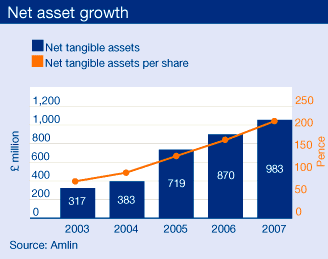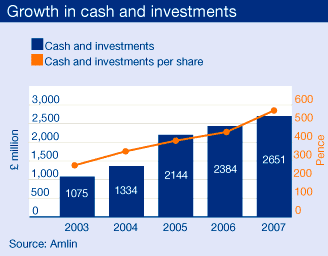Review
Financial Management – balancing financial risk and return
 Richard Hextall Group Finance Director
Richard Hextall Group Finance Director
Active financial management is fundamental to delivering the financial strategy of the business. We focus on:
- Understanding the level of capital required to operate.
- Adjusting the level of equity and debt that is employed in order to enhance returns.
- Enhancing cash flow.
- Effective investment management.
- Prudently measuring the liabilities of the business.

- Return on equity of 37.8%> plan by more than 5%
- Cash and investments multiple of 2.5 times shareholders’ equity, in excess of target of 2
Active and flexible capital management has played a critical part in enhancing Amlin’s shareholder return over recent years. Management of the balance sheet has focused on the level of capital required, the type of capital employed, improved cash and investment management and the quality of assets held.
The following graphs show the performance of net tangible assets per share and cash and investments per share since 2003.
Understanding the level of capital
The first stage in effectively managing the balance sheet is understanding the level of capital required to run the business. To facilitate this Amlin has invested in developing its dynamic financial analysis (DFA) model in recent years. The DFA model predicts a range of possible financial outcomes for each area of our business, incorporating underwriting and investments, and for the business as a whole, by running thousands of simulations through a stochastic model which is derived from historic and expected variability around mean expectations.
The initial focus of DFA modelling was for the London operations where the model supports our regulatory capital assessment. Amlin is required to submit an annual Individual Capital Assessment (ICA) to Lloyd’s, which sets out the level of capital that is required to contain the risk of insolvency in any year to no greater than a probability of 0.5%. This is equivalent to a BBB insurance financial strength rating level. Lloyd’s reviews the submissions for all syndicates in the market with the intent of bringing all ICAs to an equivalent level. At that point the ICA figure is currently uplifted by 35% to bring the capital to a level to support a higher financial strength rating.
During 2007 the Syndicate model has been built upon by developing a similar model for Amlin Bermuda. Additionally, a Group model has been completed which models the expected correlations of the London and Bermuda businesses – an important feature given the overlap of business between the two.


For Syndicate 2001, our uplifted ICA is 42% of the expected premium income, after deduction of brokerage, for 2008. This ratio has increased by 7% on the modelled ratio since 2007, although for regulatory capital purposes this was previously uplifted to the Lloyd’s minimum ratio of 40%. The increase reflects the expected reductions in profit margins across the business as market conditions soften. However, due to an expected reduction in exposure, as our underwriters withdraw into a softening market, the absolute level of regulatory capital required for 2007 fell to £348.7 million (2006: £428.2 million).
The Bermudian business is still developing in scale and we hold net assets in Bermuda of around US$1.5 billion. We continue to believe that US$1 billion is the minimum amount of capital required to trade with our preferred client base.
In addition to regulatory capital requirements we believe that we should retain a level of capital within the Group to allow it to grow its exposures materially in the aftermath of a major insurance disaster.
